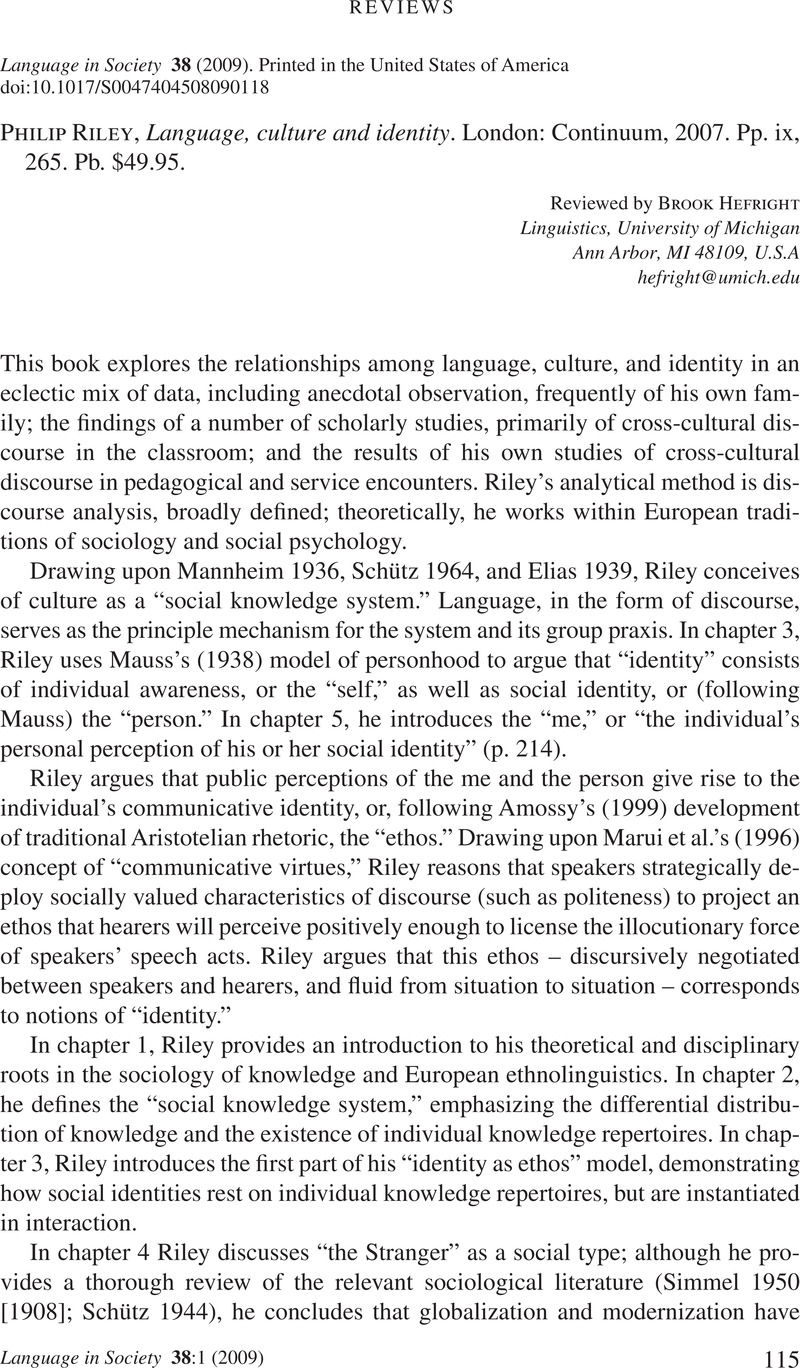No CrossRef data available.
Article contents
Philip Riley, Language, culture and identity. London: Continuum, 2007. Pp. ix, 265. Pb. $49.95.
Published online by Cambridge University Press: 01 February 2009
Abstract
An abstract is not available for this content so a preview has been provided. Please use the Get access link above for information on how to access this content.

- Type
- Book Reviews
- Information
- Copyright
- Copyright © Cambridge University Press 2009
References
Amossy, Ruth (ed.) (1999). Images de soi dans le discourse: La construction sociale de l’ethos. Lausanne: Delachaux & Niestlé.Google Scholar
Bakhtin, Mikhail (1981). The dialogic imagination: Four essays. Holquist, Michael (ed.), Emerson, Caryl & Holquist, Michael (trans.). Austin: University of Texas Press.Google Scholar
Brubaker, Rogers, & Cooper, Frederick (2000). Beyond “identity.” Theory and Society 29:1–47.CrossRefGoogle Scholar
Bucholtz, Mary, & Hall, Kira (2004). Theorizing identity in language and sexuality research. Language in Society 33:469–515.CrossRefGoogle Scholar
Bucholtz, Mary, & Hall, Kira (2005). Identity and interaction: A sociocultural linguistic approach. Discourse Studies 7:585–614.CrossRefGoogle Scholar
Duranti, Alessandro (1997). Linguistic anthropology. Cambridge: Cambridge University Press.CrossRefGoogle Scholar
Eckert, Penelope, & McConnell-Ginet, Sally (1992). Think practically and look locally: Language and gender as community-based practice. Annual Review of Anthropology 21:461–90.CrossRefGoogle Scholar
Elias, Norbert (1939). The civilising process. Edmund, Jephcott (trans.). Oxford: Blackwell.Google Scholar
Irvine, Judith T., & Gal, Susan (2000). Language ideology and linguistic differentiation. In Kroskrity, Paul (ed.), Regimes of language, 35–83. Santa Fe, NM: School of American Research.Google Scholar
Kulick, Don (2000). Gay and lesbian language. Annual Review of Anthropology 29:243–85.CrossRefGoogle Scholar
Lave, Jean, & Wenger, Etienne (1991). Situated learning: Legitimate peripheral participation. Cambridge & New York: Cambridge University Press.CrossRefGoogle Scholar
Livia, Anna, & Hall, Kira (1997). “It’s a girl!”: Bringing performativity back to linguistics. In Livia, Anna & Hall, Kira (eds.), Queerly phrased: Language, gender and sexuality, 3–18. Oxford & New York: Oxford University Press.CrossRefGoogle Scholar
Mannheim, Karl (1936). Ideology and utopia. Edward, Shils (trans.). London: Routledge & Kegan Paul.Google Scholar
Marui, Ichiro et al. (1996). Concepts of communicative virtues (CCV) in Japanese and German. In Hellinger, Marlis & Ammon, Ulrich (eds.), Contrastive sociolinguistics, 385–409. Berlin: Mouton de Gruyter.CrossRefGoogle Scholar
Mauss, Marcel (1938). Une catégorie de l’ésprit humain: La notion de personne, celle de ‘Moi.’ Journal of the Royal Anthropological Institute 68:263–81.Google Scholar
Ochs, Elinor, & Schieffelin, Bambi (1983). Acquiring conversational competence. Boston: Routledge & Kegan Paul.Google Scholar
Ochs, Elinor, & Schieffelin, Bambi (1984). Language acquisition and socialisation: Three developmental stories and their implications. In Shweder, Richard A. & LeVine, Robert A. (eds.), Culture theory: Essays on mind, self and emotion, 276–320. Cambridge: Cambridge University Press.Google Scholar
Ochs, Elinor, & Schieffelin, Bambi (eds.). (1986). Language socialisation across cultures. Cambridge: Cambridge University Press.Google Scholar
Peirce, Charles Sanders 1955 [1940]. Logic as semiotic: The theory of signs. In Buchler, Justus (ed.), Philosophical writings of Peirce: Selected writings. 98–115New York: Dover.Google Scholar
Schütz, Alfred (1944). The Stranger: An essay in social psychology. American Journal of Sociology 29:499–507.CrossRefGoogle Scholar
Schütz, Alfred (1964). Studies in social theory, collected papers. Broderson, Arvid (ed.). The Hague: Martinus Nijhoff.CrossRefGoogle Scholar
Silverstein, Michael (1976). Shifters, linguistic categories, and cultural description. In Basso, Keith H. & Selby, Henry A. (eds.), Meaning in anthropology, 11–55. Albuquerque: University of New Mexico Press.Google Scholar
Silverstein, Michael (1993). Metapragmatic discourse and metapragmatic function. In Lucy, John A. (ed.), Reflexive language: Reported speech and metapragmatics, 33–58. Cambridge & New York: Cambridge University Press.CrossRefGoogle Scholar
Silverstein, Michael (2003). Indexical order and the dialectics of sociolinguistic life. Language and Communication 23:193–229.CrossRefGoogle Scholar
Simmel, Georg(1950 [1908]). The Stranger. In Wolff, Kurt H. (trans., ed.), The sociology of Georg Simmel, 402–8. London: Free Press.Google Scholar
Wenger, Etienne (1998). Communities of practice, learning, meaning and identity. Cambridge: Cambridge University Press.CrossRefGoogle Scholar




